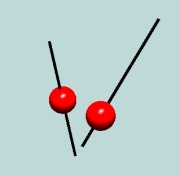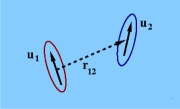| |
EXISTING MODELS
-
The need for "generic" models


|
|
-
5CB, a popular liquid crystal molecule
-
It may be modeled by 19+ LC centers, different in size and depth, and
positioned as shown
-
Used for realistic simulations, to be compared to experiment
-
Less suited for theory
-
PMMA (= vinyl glass): more linear, but even more centers
|
-
Multisite model
| |

|
|
-
Several (4...8) identical LJ sites
in regular distances
-
Pro:
-
captures some of the physics - see balls-and-sticks models
-
Con:
-
many interactions per pair
-
not convex everywhere
-
hard body limit (= fused hard spheres) afflicted by metastability
-
But useful for gauging the Gay-Berne potential (see below)
|
-
Kihara model
| |

|
|
-
Find the points of least mutual distance along
the two axes, then place an LJ center in each of these
"proxy points"
-
Pro:
-
very quick (only one LJ interaction)
-
hard body limit is the well-studied spherocylinder (HSC)
-
exhibits pronounced LC behaviour (nematic+smectic)
-
Con:
-
physics is wrong: side-by-side interaction is no
stronger than end-to-end (compare 4LJ: factor $\approx 5$)
|
-
Gay-Berne model
| |

|
|
-
Great math, due to Berne-Pechukas; see
here
-
But: fuzzy physics; see
here
-
Gay-Berne: adapted Berne-Pechukas and defined standard
parameters by comparing to 4-Lennard-Jones model
(see above); later modified by Luckhurst.
See full GB formula
-
The Gay-Berne potential has four adjustable parameters
-
Pro:
-
may be adjusted to represent anything from saucers
to cigars
-
Con:
-
parameters must be gauged anew for any shape;
not suited as reference potential
-
Hard body limit: "Hard Gaussian
Overlap" (HGO) model;
has no definite shape; no pronounced LC phases
|
|
vesely nov-2006
|
